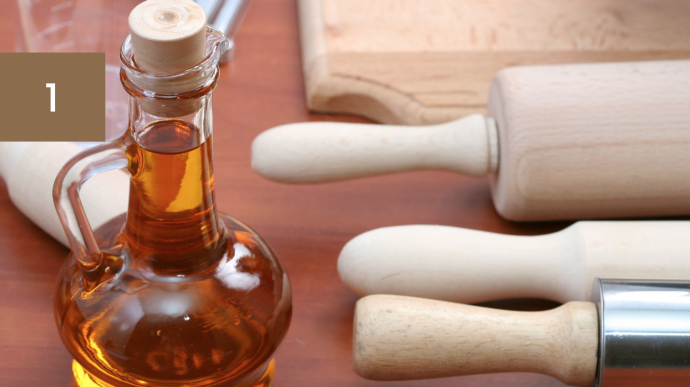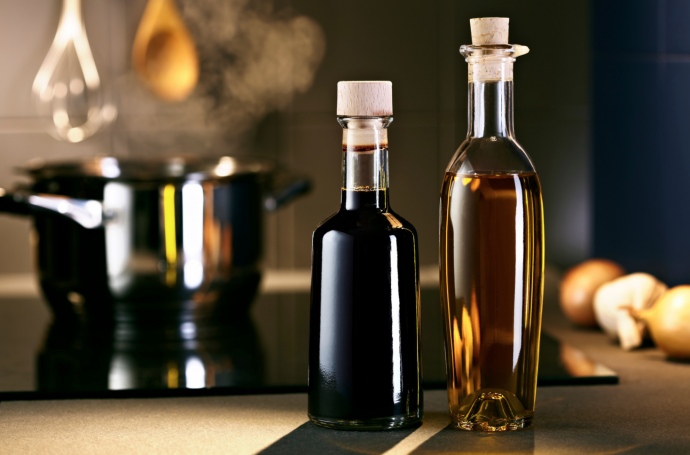Cooking oil is one of the most reliable tools in a cook’s bag of tricks. The oil can be used in baking and frying, among other cooking methods, and is noteworthy for the flavoring it adds to a wide variety of dishes. I don't do much deep-frying, but I do use plenty of oil for sautéing, frying and roasting. Whether it's chicken or roasted vegetables, oil is essential to many, if not most of my main and side dish recipes. It's also a staple of my salad dressings. So I got to thinking about oil and tips for using it. So, I collected some hints on effective cooking with oil, and I hope, these handy tips will help you make your time in the kitchen a little bit more pleasant!
Disposing of oil neatly.

Deep-fried foods are a real treat, but cleaning up after frying is not. Disposing of the spent oil neatly and safely is a particular challenge. Try making a quadruple- or quintuple-layered bag using four or five leftover plastic grocery bags. With someone holding the bag open over a sink or in an outdoor area, carefully pour the cooled frying oil from the pot into the innermost bag. Tie the bag handles shut before disposing of the oil.
The pan flip that stops drips.

Pouring melted butter, warm oil, sauce, or almost any liquid from a pan often creates a drip down the outside of the pan. This not only makes a mess on the pan’s exterior but the drips can burn onto the pan bottom if you place it back on a hot burner. But you can prevent the drip with a simple flick of the wrist. Instead of immediately turning the pan right side up after pouring out the contents, continue to turn the pan in the direction of the pour, through one full rotation, until it eventually ends right side up. This forces the liquid to run back into the pan instead of down its side.
Don’t sweat oil drips.

A. To prevent unsightly oil stains on pantry shelves, try wrapping a clean sweatband around the middle of the bottle of oil to catch drips. When the band becomes too dirty, clean it in the washing machine.
B. Alternatively, a band of folded paper towels can be fastened around the bottle with a rubber band and simply thrown away when dirty.
Getting a grip on slick bottles.

Because grabbing an olive oil bottle or can of vegetable oil spray with floured or greasy hands can be a slippery task, you might want to add some traction. Place a rubber band around the container. Now you have a no-slip grip on the spray.
Give your kitchen a shine.

Olive oil is the perfect way to breathe new life into your pots and pans, or anything else made of metal. All you need to do is put a tablespoon of oil on a paper towel and give your pots and pans a quick polish, and they'll look awesome. This is my go-to trick for when I'm entertaining guests and need my serving pots to look their best.
Make garlic oil.

Garlic and olive oil is a match made in heaven. In fact, garlic oil is my single favorite condiment; it's perfect on pizzas, meats, sandwiches and... Well, heck, anything savory. Check out our primer on making garlic-infused oil to learn how to make blissfully flavored oil. Or, you can make the raw version by simply mincing some garlic and adding olive oil.
Store oil properly.

Store oil in a refrigerator or in a cool, dark location as both light and heat damage oil. Oil may turn cloudy in the refrigerator, but that will not affect quality and the cloudiness will disappear after a short time at room temperature. If you wonder whether oil is still good, smell it – if you’ve ever smelled rancid oil, you know what I’m talking about.
Safety first.

When heating oil, bring it up to the appropriate temperature slowly – don’t turn the burner on full blast at the beginning. Avoid splattering hot oil by adding food gently – don’t dump it into the pan. In particular, make sure the food is dry. Water droplets introduced into hot oil causes splatters that “jump.” Blot damp food with a paper towel before putting it in hot oil.
If oil or food cooking in oil starts to burn, don’t throw water on it! Turn the burner or oven off and cover it with a tight fitting lid. Or, douse the flames with baking soda.









